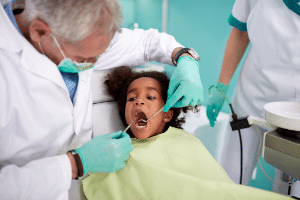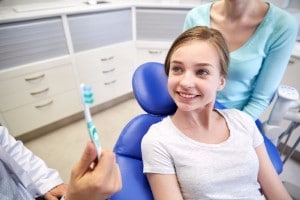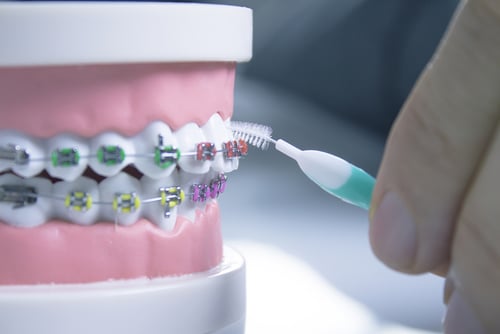Learn How Two Phase Orthodontic Treatment Can Help Your Child Achieve a Perfect Smile!
Perhaps the most significant physical change that a child undergoes on the way to adulthood is based in oral health. Between the ages of six and twelve, every last tooth in a child’s mouth will fall out and be replaced, and eight new teeth will sprout from the rear portion of the gums. A child’s teeth may grow in without any complications, perfectly even and supporting proper diction. However, depending on contributing factors such as genetics, environment, habits, and hygiene, issues such as crowding, malocclusion, and misalignment are commonplace. In order for these problems to not worsen over time and negatively impact your child’s well-being, intervention at a young age is necessary. Depending on the child, our Buffalo orthodontists may use one or two phase orthodontic treatment that is customized to suit the needs of each of our younger patients.
After a preliminary examination, we develop an action plan to implement as we guide our patients’ teeth into the proper positions. This approach has allowed our patients to achieve a functional and even dental layout before they enter high school. If you or someone you love is considering orthodontic treatment to help improve their smile or function, schedule a free consultation today to learn more about our two phase orthodontic treatment.
Overview of two phase orthodontic treatment:
1. An Early Assessment Is the Foundation for Eventual Success.
 At Orthodontists Associates, we emphasize the importance of early screening and treatment, directing dental-facial development towards a strong skeletal and dental relationship once all permanent teeth have erupted. This phase involves treating many of the contributing factors to poor dental-facial development. If a child is on a bad path of dental-facial development, we do not typically recommend that the child’s treatment be delayed. We do not subscribe to the philosophy of waiting until a patient is older and has all of her or his permanent teeth. Always waiting until a child has reached a certain age is a reactive approach to early orthodontic treatment. We choose instead to be proactive, employing Phase I and two phase orthodontic treatment as early as needed.
At Orthodontists Associates, we emphasize the importance of early screening and treatment, directing dental-facial development towards a strong skeletal and dental relationship once all permanent teeth have erupted. This phase involves treating many of the contributing factors to poor dental-facial development. If a child is on a bad path of dental-facial development, we do not typically recommend that the child’s treatment be delayed. We do not subscribe to the philosophy of waiting until a patient is older and has all of her or his permanent teeth. Always waiting until a child has reached a certain age is a reactive approach to early orthodontic treatment. We choose instead to be proactive, employing Phase I and two phase orthodontic treatment as early as needed.
2. Phase I is Chiefly Concerned with Functionality.
 Phase I comprises all actions taken early in the orthodontic process, typically in the mixed dentition. In Phase I treatment, we try to develop better functional relations between the upper and lower jaw, so that as a patient transitions into permanent dentition, he or she approaches the goal of orthodontic treatment. Phase I orthodontics prioritizes crowding situations. We further develop the maxilla, which may be too narrow. There are many factors that can create maxillary deficiency, from thumb sucking to mouth breathing habits to feeling tongue-tied. To an orthodontist, “tongue-tied” means that a patient does not have enough of a range of motion in her or his tongue. Because of this limited range of motion, the tongue does not express itself against the palate, and that force is necessary for the roof of the mouth to develop appropriately and prevent crowding of the teeth.
Phase I comprises all actions taken early in the orthodontic process, typically in the mixed dentition. In Phase I treatment, we try to develop better functional relations between the upper and lower jaw, so that as a patient transitions into permanent dentition, he or she approaches the goal of orthodontic treatment. Phase I orthodontics prioritizes crowding situations. We further develop the maxilla, which may be too narrow. There are many factors that can create maxillary deficiency, from thumb sucking to mouth breathing habits to feeling tongue-tied. To an orthodontist, “tongue-tied” means that a patient does not have enough of a range of motion in her or his tongue. Because of this limited range of motion, the tongue does not express itself against the palate, and that force is necessary for the roof of the mouth to develop appropriately and prevent crowding of the teeth.
3. Phase II Fills in All the Leftover Gaps.
 During Phase I, we observe dental development until all the permanent teeth erupt. Then, we determine whether there is a stable or a functional relationship between the upper and lower rows of teeth. If Phase I has produced functional results, two phase Orthodontics may be irrelevant to a patient’s dental health. If we think can improve upon the results of Phase I, we recommend a full set of braces to detail.
During Phase I, we observe dental development until all the permanent teeth erupt. Then, we determine whether there is a stable or a functional relationship between the upper and lower rows of teeth. If Phase I has produced functional results, two phase Orthodontics may be irrelevant to a patient’s dental health. If we think can improve upon the results of Phase I, we recommend a full set of braces to detail.
Phase II orthodontic treatment commences once every permanent tooth has emerged. By and large, most of our child patients undergo the two phases of orthodontics before high school begins.
Schedule A Free Orthodontic Consultation Today!
An improper bite and significant malocclusion can have detrimental effects on a child’s oral health and speaking capabilities, and there is the potential for complications to ensue that could lead to pain, infection, and surgical interference. Providing your child with orthodontic care early on is critical, as monitoring the eruption (growing in) of permanent teeth can detect these issues before they arise. Our orthodontists in Buffalo, NY have decades of experience helping children acquire perfectly aligned teeth, so if you have concerns about your child’s orthodontic needs, consult our practice today on two phase orthodontic treatment.
Follow us on Facebook for our latest COVID-19 updates and oral health tips!

